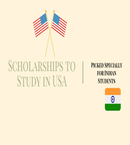As of 2021, there were over 500,000 Indian immigrants in the United States. Today, Indian immigrants account for approximately 1.2 percent of the US population, making them the country's second-largest immigrant group. The cost of living in USA for international students has risen by 14% over the previous year.
The average monthly cost of living in the United States for international students ranges between USD 1,000 and USD 3,000, excluding course costs. Student accommodations in the US make up a major part of the overall cost of attendance. Despite the high costs required, the United States government invests 476,452 million USD in research and development, accounting for 2.7 % of its entire GDP.
The cost of living in the United States varies from student to student depending on their lifestyle, location, and type of accommodation, among other considerations. San Francisco, New York, Boston, and Los Angeles are among the most costly cities. Living in New York, for example, might cost around USD 4,600 per month, whilst living in Boston can cost roughly USD 3,500 per month. Also Check: Funding options to study in USA
Factors Affecting the Budget
While deciding upon various aspects which affect your budget, you must not ignore any kind of expense. Save as much as possible and keep a note of emergency expenditure.
Mentioned are major areas of expenses that affect your budget considerably.
| Tuition | Books | Loans |
| Rent | Communication | Health Insurance |
| Food | Transportation | Personal Expenses |
Note: In case you receive scholarships or fellowships, it is non-taxable.
Estimate of Expenses in the U.S.
Pre arrival Expense
Apart from regular expenses in the U.S., there are expenses before you reach the university. These expenses are one-time and are a considerable amount.
| Expense | Average Cost (in USD) |
|---|---|
| Standardized exams | 185- 275 |
| Application fees of the universities | 50- 100 |
| VISA Processing Fee | 160 |
| SEVIS Fee | 350 |
| Health Insurance | 500- 1000 |
In case the students get an assistantship, they will be paid at the end of the month. Meanwhile, they must survive for one month on their own funding resources.
Regular Expenses
Mentioned are the factors considered for expenditure in daily life. The average expense range is mentioned along with the estimated percentage contribution of each item in a month.
| Item | Percentage Contribution | Approximate Expense Range (Monthly) |
|---|---|---|
| Rent of Apartment | 35.6% | 650- 25,000 |
| Meals | 22.58% | 30- 40 (one-meal) |
| Transportation | 7.45% | 100- 300 |
| Personal Expenses | 15.99% | 300- 600 |
| Health Insurance | 18.33% | 450- 700 |
Note: The values for percentage contribution and expense range are subject to change. They may vary.
Estimate of Student Expenses based on School type and Environment
Type of School: Public or Private School
Public schools cost less when compared to private schools. But, students in private schools have an edge over public schools in comparison to scholarships. Private schools offer better scholarships than public schools. Lastly, Community colleges are less expensive for undergraduate and graduate degrees in comparison to other colleges.
Type of Environment: Urban or Rural Environment
A school in a rural area costs less than a school in an urban area. An apartment in the urban region is almost double of the same in a rural region. The same concept applies to the cost of different amenities in different regions.
Expenditure based on anything, a school or a region affects directly on the students.
The average expenditure of public and private schools:
- Average annual expenses for public state university – 35,000 USD to 45,000 USD
- Average annual expenses for private state university – 65,000 USD to 75,000 USD
Note: The figures include tuition, books, board and room and miscellaneous.
The F-1 Visa Budget
The only one-time expense that cannot be avoided or reduced. The SEVIS costs or F1 visa fees add extra 25,000 INR (360 USD) to the cost of your trip to the United States. The US student visa fees that need to be paid at various levels of the entire process are as tabulated below.
| Type of Fee | Cost (in USD) |
|---|---|
| Non-petition based Nonimmigrant Visa Fees (Except J visa) | 160 |
| Petition based Nonimmigrant fees | 190 |
| Border crossing card fees | 160 (for 15 years above age) |
Budget Institutions in the U.S. for International Students
Though the majority of universities in the U.S. are expensive, there are certain well-known institutions which offer reasonable tuition fees to international students.
Mentioned are those universities along with the corresponding tuition fee:
| Universities | Average Tuition Fee |
|---|---|
| Coppin State University | 11,266 |
| South Dakota State University | 12,570 |
| University of Nebraska—Kearney | 13,650 |
| Murray State University | 14,000 |
| Southeast Missouri State University | 14,205 |
| Indiana University—South Bend | 14,637 |
| Monroe University | 14,976 |
| California State University—Fresno | 15,000 |
| Truman State University | 15,000 |
| University of Akron | 15,500 |
| Western Michigan University | 15,806 |
| Minnesota State University—Mankato | 16,984 |
| Minnesota State University | 18,200 |
| Lindenwood University | 18,500 |
| Southern Illinois University—Carbondale | 26,000 |
Manage Budget through Scholarships for International Students
The funding options available to Indian students in USA include Scholarships, Fellowships, and Loans. Scholarships are one of the best ways to save your earnings. Maximum scholarships cover tuition and other charges. Scholarships to study abroad can be broadly categorized into four categories. These are as follows:
- Government-funded scholarship
- Program-specific scholarship
- Subject-specific scholarships
- Organization Provided
One of the most famous scholarships provided to students in different domains are Fulbright scholarships. Mentioned are the varied and well-known scholarships offered to international students in the U.S.
| Name of Scholarships | Number of Awards | Value |
|---|---|---|
| Fulbright Foreign Student Program (Government) | 4,000 | The grant funds tuition, airfare, a living stipend, and health insurance for the duration of the study |
| Hubert Humphrey Fellowship Program (Government) | 200 Fellowships | Pay tuition and fees, Pre-academic English Training, living allowance, accidental insurance, Air Travel and Professional activities such as field trips and conferences |
| Next Genius Scholarship Program | Selective 2nd or 4th year undergraduate student | 1,000 USD |
| Rotary International Ambassadorial Scholarships | Variable | 12,000 USD - 25000 USD |
Universities offer loads of scholarships to international students. No matter where you attend your school, you simply visit the financial aid office and look for the suitable scholarships for yourself. Students can visit the financial aid website of their institution where they can find suitable aid.
Apart from the above-given options, there are numerous offers waiting for you around the world by various international organizations. Aspirants may benefit through this aid for tuition fee and living allowance.
Sources of Financial Support
- Home Country
- Employment
- Scholarships for International Students
- The U.S. Government and Universities
- International Student Loans
- International Organizations – UN, Fulbright, WHO and more
Some more Budgeting Options
- Stipend/Salary for Internship: If the internship is compensated, the student will receive income to assist offset their expenses. If your employer cannot provide a stipend or pay, try negotiating a housing allowance or a transportation/meal allowance.
- Native Government-funded scholarship: Your country's government may have funding and scholarships available to which you might apply. Conduct some investigation into potential funding sources. This could be done at the municipal, regional, or state/provincial levels.
Budget States in the U.S.
Mentioned are the cheapest options to study in the USA Average home price in each state will provide an idea about the amount of expenses.
| City | Accommodation (in USD) |
|---|---|
| Boston | 1,927- 2,687 |
| New York | 2,094- 3,064 |
| San Francisco | 2,495- 2,900 |
| Chicago | 1,205- 1,842 |
| Los Angeles | 1,663- 2,214 |
Budgeting Tips
- Keep your track: Once you've determined how much you'll spend each month, it's critical to stay to that figure.
- Emergency Fund: It's usually a good idea to have an emergency fund, which is a savings account where money is placed away in case you truly need it.
- Student discounts: You can obtain a student discount card or simply browse for student pricing on travel and entertainment. Remember to bring your student ID card.
- Remember to budget for travels: you'll want to take advantage of the weekends or the 30-day grace period at the end of your programme to get some sightseeing in.


![Massachusetts Institute of Technology [Mit]](https://static.zollege.in/public/college_data/images/studyabroad/logos/college_1087_29-14:42_download.png?tr=w-50,h-50,c-force?tr=h-40,w-35,c-force)
![University of California [Uc Berkeley]](https://static.zollege.in/public/college_data/images/studyabroad/logos/college_982_24-16:13_download.png?tr=w-50,h-50,c-force?tr=h-40,w-35,c-force)

![University of Chicago [Uchicago]](https://static.zollege.in/public/college_data/images/studyabroad/logos/college_1129_06-15:23_logo.png?tr=w-50,h-50,c-force?tr=h-40,w-35,c-force)







1641992784.jpg?tr=w-305,h-145,c-force?tr=h-130,w-130,c-force)




